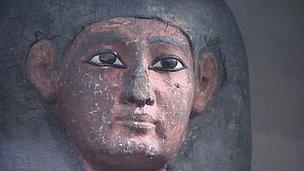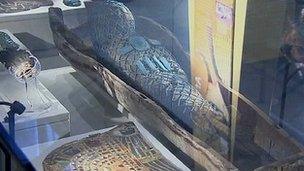Rare Egyptian coffin identified in Torquay Museum
- Published

The coffin pre-dates the mummified boy's body it contains by 1,000 years
A coffin on display at a museum in Devon is a rare 3,500-year-old Egyptian sarcophagus, it has emerged.
Torquay Museum were unaware of the coffin's significance until an expert from Bristol University identified it as one of only two in the country.
Dr Aidan Dodson, who is cataloguing the country's Egyptian artefacts, believes the coffin pre-dates the mummified boy's body it contains by 1,000 years.
He said: "It's very significant as very few coffins of that period survive."
The highly decorated sarcophagus and the mummified remains of a boy, aged between three and four, were donated to the museum in the 1950s.
But the artefacts were kept in storage for years and rarely displayed until 2007 when they were selected as the centrepiece of an Egyptian exhibition.
"When I walked into the museum for the first time I realised that the coffin was something really special," said Dr Dodson.
"Not only was it of a design of which there is probably only one other example in the UK [in Bristol], but the quality was exceptional."
The "very high quality" coffin has been carved from a single log of cedar wood, inlaid and painted. It is thought to have originally been made for a member of a very wealthy family - perhaps even royalty.
Coffin reused
The inscription on the coffin, according to Dr Dodson, has been "reworked at some point for a new owner" and shows "plenty of signs of re-use".
"It was quite common in ancient Egypt to re-use coffins." he said.

The museum said it had always thought the coffin and its contents had not gone together
"So a previous occupant might have been turfed out for it to be re-used in a later period by someone else.
"Unfortunately, the part of the inscription which named the boy and his parents is so badly damaged that we cannot be certain."
Both the coffin and its contents were donated to the museum in 1956 by Lady Winnaretta Leeds, daughter of sewing machine heir Paris Singer.
It was during one of her visits to the Middle East in the 1920s that she is thought to have bought the coffin and mummy.
Museum curator Barry Chandler said the museum always thought the coffin and its contents had not gone together but it was "an extraordinary discovery".
"We thought perhaps the coffin dated back another 200 years or so to about 700 BC," he said.
"But we never realised it had actually been made somewhere between 1525 and 1470 BC.
"It's extremely rare - even the British Museum doesn't have one quite like it."